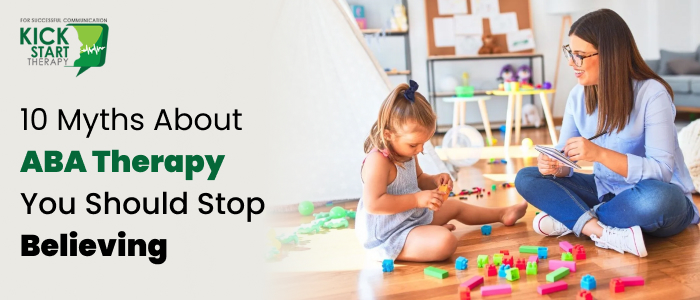
Applied Behavior Analysis (ABA) therapy is a widely recognized, science-backed approach to improving behavioral, social, learning, and communication skills in individuals by applying positive reinforcement. Based on the principles of behavior analysis, ABA therapy works by understanding the relationship between an individual’s behavior and their environment.
The therapy has shown improvement in social, communication, and academic skills in up to 90% of individuals with ASD. The therapy’s effectiveness lies in its three fundamental components: setting clear goals, reinforcing positive behaviors, and tracking measurable outcomes.
Despite the widespread recognition and consideration as one of the effective treatments for autism, ABA therapy remains the subject of controversy and misconceptions. While many advocate the success of this therapy, others call it a bribe system to manipulate the child’s behavior.
When you are in a problem and if it's related to your child, it is obvious to believe everyone’s suggestions and get overwhelmed by the misconceptions. However, when it’s about the well-being of your loved ones, it's better to rely on scientific evidence than believe myths and misconceptions. So, in this write-up, we will debunk some of the common myths regarding ABA therapy to give a clear and more accurate understanding of this effective approach.
Applied Behavior Analysis (ABA) therapy is an evidence-based approach to improving the behavior and social skills of individuals with autism spectrum disorder (ASD). It has been scientifically proven to be effective in increasing positive behaviors while reducing problematic ones and has been in practice since the 1960s.
The therapy works on systematic interventions, using different techniques to encourage positive behaviors and discourage negative behaviors. The goal of an ABA therapist is to help individuals improve their quality of life by reducing dependency on others.
ABA therapy uses reinforcement to shape behavior. It involves pairing a reward or stimulus with positive actions to encourage those actions over time, using a structured plan.
The misinformation around ABA therapy (Applied Behavior Analysis) still exists because many people don’t have the right information. Here are the main reasons why these myths continue:
Many people simply don’t know enough about ABA therapy. They might hear the term but don’t understand what it really involves. Without proper education, they rely on word-of-mouth, which can be misleading. Schools, doctors, and therapists don’t always explain ABA clearly, so confusion grows. When people aren’t taught the facts, they become myths.
ABA therapy has evolved over the years, but some still believe old stereotypes. In the past, some ABA methods were more rigid or harsh. Today, ABA focuses on positive reinforcement and is more personalized. However, people who aren’t updated think ABA is still the same as it was decades ago. They criticize old practices without realizing how much has changed.
TV shows, movies, and social media often get ABA wrong. Some portray it as cruel or controlling, using extreme examples that don’t reflect modern ABA. Dramatic stories get more attention than facts, so people assume ABA is harmful. Even well-meaning advocates sometimes spread incorrect information because they rely on these exaggerated portrayals.
Everyone’s experience with ABA is different. Some people share negative stories—maybe they had a bad therapist or an outdated program. These stories are important, but they don’t represent ABA as a whole. Unfortunately, emotional stories spread faster than facts. When people hear one bad experience, they might assume all ABA is like that, even though many others have benefited from it.
There are numerous misconceptions and criticisms about the effectiveness of ABA therapy; however, modern scientific findings have debunked them to a great extent. But, still, there are some myths that will take even longer to dispel, as they are deeply rooted in outdated beliefs and a lack of awareness about the advancements.
No, ABA therapy isn’t only for kids with autism. Many people think it’s just for autism, but it works for many other behavior and mental conditions. It’s a way to teach new things and make hard behaviors better, no matter how old someone is or what challenges they have.
Kids with autism should start ABA early because it helps them learn fast, but it works for older kids and grown-ups too. It’s also good for little ones with different growing troubles, not just autism. Starting ABA anytime can teach skills and make life easier.
ABA therapy can help with more than autism. It’s useful for kids with ADHD, where they can’t sit still or focus. It works for delays in growing up or when thinking is tough. Furthermore, it teaches how to talk better, play with friends, and do things on their own, step by step.
ABA therapy helps kids by focusing on how they act. It uses rewards to teach good behaviors. When a child does something good —like sharing—they get a treat or praise. This makes them want to do it again. Rewards are a big part of ABA because they keep kids motivated.
Sometimes, ABA stops bad behaviors without being mean. Instead of punishing, it might take away something a child doesn’t like—like a loud noise—when they act nicely. This isn’t punishment; it’s a trick to help them choose better actions. Punishment isn’t the main way in ABA.
ABA mixes these ideas to help kids learn. It teaches them to talk, play with others, or stay calm by making good choices feel worth it. The goal is to build new skills and lower tough behaviors, all with kindness and clear steps.
ABA therapy is flexible enough to match what each kid needs. Therapists first watch and learn about your child. They find out what your child is good at, what’s hard, and what they like. Then, they make a special plan just for them, with steps to help them grow.
However, this isn’t the same for everyone. Therapists keep checking how your child is doing. If something isn’t working, they fix the plan. They tweak things so it always helps your child, even as they change. ABA keeps moving and improving.
They also think about where your child live and what they do every day. The skills they teach—like talking or playing—work at home, school, or anywhere. ABA focuses on things that matter, so your child can do more on their own and feel good wherever they are.
ABA therapy isn’t just about fixing negative behaviors. It also helps kids learn new things to make life better. Therapists teach skills like talking, making friends, doing schoolwork, taking care of themselves, and living on their own one day. It’s about growing, not just stopping problems.
The goal is to help your child do more and feel good. Learning these skills lets them fit in with others and do well at home or school. ABA builds a stronger, happier kid, not just a quieter one.
Therapists use easy steps to teach. They split big tasks into small pieces, show the way clearly, and help until your child gets it. Over time, they step back as your child does more alone. It’s all based on what works, making sure every lesson sticks for real life.
ABA therapists know your child’s feelings matter. They see that how a kid acts comes from what they feel inside. So, they pay attention to your child’s emotions during therapy, not just their actions.
They make a warm, kind environment where your child feels safe and important. Therapists build trust with your child, listening and understanding them. This helps your child learn to handle big feelings, know themselves better, and find ways to feel okay when things get hard.
Therapists look at what your child likes and what makes them happy. They use those things in therapy to keep your child interested and involved. It’s all about helping your child feel good while they grow, step by step.
ABA therapy is a slow journey that needs regular work. It helps kids change behaviors and learn skills, but it isn’t a quick fix. Every step takes effort and lots of practice to stick.
It’s not something that gives results in 1–2 days. How long it takes depends on your child. Some kids need therapy a bunch of times a week. Others need less. It’s about what fits them. Sticking to a steady plan helps the skills grow strong and work everywhere.
Therapists team up with parents and others who help your child. They make sure everyone keeps the same support going at home, school, or wherever. It’s a big job that needs patience.
Even though it takes time, ABA really helps. Studies show it makes talking, playing with friends, and everyday stuff better for kids with autism or other challenges. It’s worth it for the good it brings.
ABA therapy uses fun things to help kids do good behaviors and is not just centered around giving food as a reward. It could be saying “great job,” giving a sticker, letting them play with a favorite toy or a quick pat on the back. It is not a trick to make them act—it’s a way to encourage them.
Therapists figure out what your child likes the most. They watch and ask to find out what makes your child happy. This way, the reward feels special and keeps them excited to try hard.
The point is to show kids that good actions are worth it. Using different fun rewards keeps things lively. It helps them learn new stuff and act better in a happy way.ABA therapy is a research-backed, evidence-based treatment approach for ASD. Many studies have revealed that ABA helps kids with autism learn better and behave nicer.
The studies show it’s good at teaching new things and making tough actions go away. This isn’t just talk—real checks show it helps kids grow strong and happy. ABA uses what these researchers found to make therapy that really works.
ABA therapy starts with understanding why kids do such behaviors. It’s based on watching behavior and finding out what starts it. Therapists dig into what happens before a behavior, not just the action itself.
This helps them see the real reasons behind it. Then, they make special plans to fix those reasons and help behaviors change for good. ABA therapy makes ideas that fit each kid perfectly, based on what’s going on with them.
ABA therapy doesn’t turn kids into robots or make them sad. It’s all about making their days better by teaching them new things and calming tough behaviors.
With kind rewards and plans just for them, ABA helps kids with autism grow strong. They get better at talking, playing with others, and doing everyday stuff, which makes them feel good inside. It doesn’t hide who they are—it helps them shine and handle life easier.
ABA therapy helps kids in many ways. It’s a way to teach new things and make hard behaviors better. Here’s how it works for families.
Finding good ABA therapy for your child is easy if you know what to look for. Start by checking out Kick Start Therapy —we offer the best ABA therapy in Brampton and Mississauga. We have professionally trained and certified therapists who understand kids with autism.
There are numerous myths and misconceptions about ABA therapy that people still believe, but now you know the truth. It’s not mean, boring, or just for little kids with autism. It helps all kinds of people grow and feel better.
At Kick Start Therapy, we show how ABA works with care and facts, not old stories. It takes time, but it’s worth it for real change. Stop believing these 10 myths—ABA is about helping, not hurting.
ABA (Applied Behavior Analysis) therapy is controversial because some people say it helps kids with autism learn skills, while others argue it forces them to act "normal" and ignores their feelings. Critics, including some autistic adults, feel it focuses too much on changing behavior instead of understanding the person.
Yes, ABA is backed by science and research showing it can help improve behaviors, communication, and skills in kids with autism. Studies prove it works for many, but some argue the research doesn’t cover every situation or long-term effects, so it’s not perfect for everyone.
Ethical issues with ABA include concerns about consent—kids can’t always say no. Some say it tries to "fix" autism instead of accepting it. There’s also worry about using rewards and punishments, which might stress kids out or make them feel they’re not good enough as they are.
ABA doesn’t directly increase IQ, but it can help kids learn skills like focus and communication, which might improve how they do on IQ tests. There’s no solid proof it boosts intelligence itself—just that it can help with learning and problem-solving in some cases.
Yes, ABA can be used for high-functioning autism. It’s tailored to each person, so it can help with specific challenges like social skills or routines, even if someone doesn’t need as much support. However, some say it’s less necessary for those already managing well.
ABA can help with ADHD by teaching focus and self-control through rewards and structure. It’s not made for ADHD like it is for autism, but some find it useful. Still, it might not work for everyone, and other treatments like medication or counseling are often used instead.






